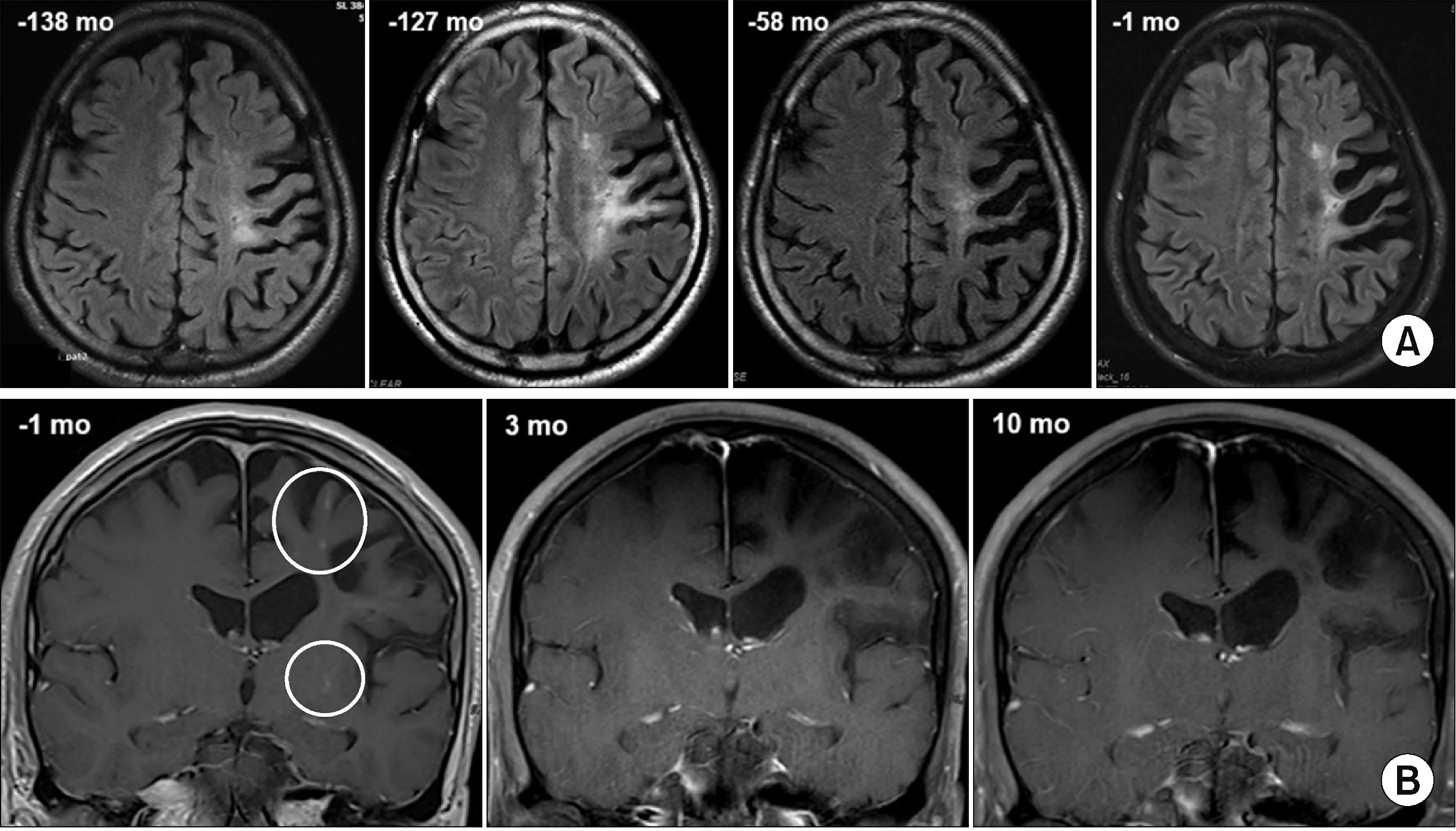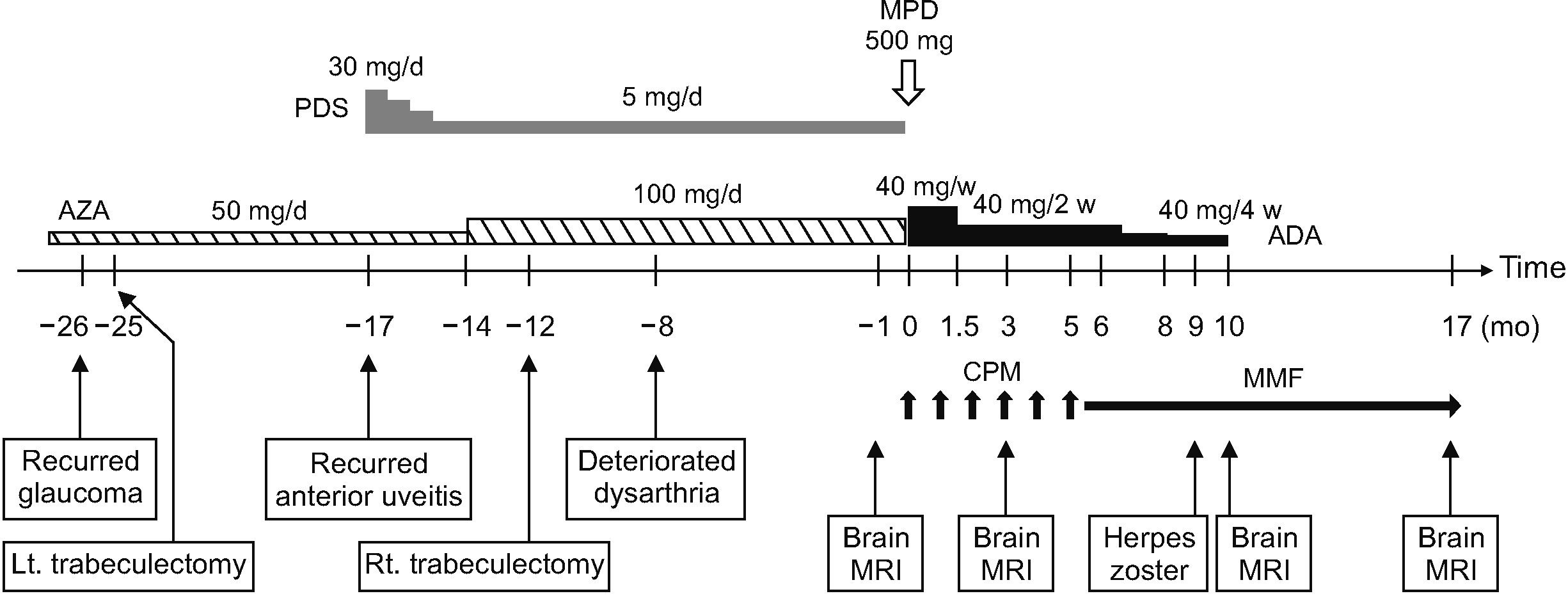J Rheum Dis.
2024 Jul;31(3):178-181. 10.4078/jrd.2023.0069.
Corticosteroid-free adalimumab-cyclophosphamide combination therapy for acute phase neuro-Behçet’s disease: a case report
- Affiliations
-
- 1Division of Rheumatology, Department of Internal Medicine, Chungbuk National University Hospital, Cheongju, Korea
- 2Division of Rheumatology, Department of Internal Medicine, School of Medicine, Kyung Hee University, Seoul, Korea
- 3Division of Rheumatology, Department of Internal Medicine, Seoul National University Bundang Hospital, Seongnam, Korea
- 4Department of Medical Device Development, Seoul National University Graduate School, Seongnam, Korea
- KMID: 2557406
- DOI: http://doi.org/10.4078/jrd.2023.0069
Abstract
- Neuro-Behçet's disease (NBD) represents a significant complication of Behçet's syndrome, potentially leading to elevated mortality and disability rates. The standard treatment for parenchymal NBD typically entails administering high-dose corticosteroids to prompt rapid-onset effects, coupled with immunosuppressants to prevent subsequent relapses. A 48-year-old male with NBD presented with progressively worsening dysarthria over 9 months. This patient experienced increased intraocular pressure while using glucocorticoids, which worsened his pre-existing glaucoma. The patient had a prior diagnosis of NBD and presented with progressive dysarthria over a period of nine months, leading to a brain magnetic resonance imaging (MRI) scan. The brain MRI revealed multifocal punctate high signal intensities in the left frontoparietal area, insula, and basal ganglia. Instead of the standard steroid pulse therapy, the patient received adalimumab-cyclophosphamide combination as an alternative induction therapy. Subsequent serial brain MRI scans exhibited no emergence of new lesions, and the patient remained devoid of clinical relapses even after 17 months from the commencement of induction treatment. Adalimumab-cyclophosphamide combination could be used as a corticosteroid-free induction strategy for NBD. Further investigations are warranted to establish the most suitable combination regimen.
Figure
Reference
-
1. Borhani-Haghighi A, Kardeh B, Banerjee S, Yadollahikhales G, Safari A, Sahraian MA, et al. 2020; Neuro-Behcet's disease: an update on diagnosis, differential diagnoses, and treatment. Mult Scler Relat Disord. 39:101906. DOI: 10.1016/j.msard.2019.101906. PMID: 31887565.
Article2. Hatemi G, Christensen R, Bang D, Bodaghi B, Celik AF, Fortune F, et al. 2018; 2018 update of the EULAR recommendations for the management of Behçet's syndrome. Ann Rheum Dis. 77:808–18. DOI: 10.1136/annrheumdis-2018-213225. PMID: 29625968.
Article3. Hirohata S, Kikuchi H, Sawada T, Okada M, Takeno M, Kuwana M, et al. 2020; Recommendations for the management of neuro-Behçet's disease by the Japanese National Research Committee for Behçet's Disease. Intern Med. 59:2359–67. DOI: 10.2169/internalmedicine.4705-20. PMID: 32611961. PMCID: PMC7644487.
Article4. Kone-Paut I, Barete S, Bodaghi B, Deiva K, Desbois AC, Galeotti C, et al. 2021; French recommendations for the management of Behçet's disease. Orphanet J Rare Dis. 16(Suppl 1):352. DOI: 10.1186/s13023-020-01620-4. PMID: 33622338. PMCID: PMC7903591.
Article5. Alpsoy E, Leccese P, Emmi G, Ohno S. 2021; Treatment of Behçet's disease: an algorithmic multidisciplinary approach. Front Med (Lausanne). 8:624795. DOI: 10.3389/fmed.2021.624795. PMID: 33996847. PMCID: PMC8115406.
Article6. Korkmaz FN, Ozen G, Ünal AU, Kahraman Koytak P, Tuncer N, Direskeneli H. 2016; Severe neuro-Behcet's disease treated with a combination of immunosuppressives and a TNF-inhibitor. Acta Reumatol Port. 41:367–71.7. Tanida S, Inoue N, Kobayashi K, Naganuma M, Hirai F, Iizuka B, et al. 2015; Adalimumab for the treatment of Japanese patients with intestinal Behçet's disease. Clin Gastroenterol Hepatol. 13:940–8.e3. DOI: 10.1016/j.cgh.2014.08.042. PMID: 25245624.
Article8. Luo G, Falta EM, Elster EA. 2005; Steroid-free immunosuppression in organ transplantation. Curr Diab Rep. 5:305–10. DOI: 10.1007/s11892-005-0028-x. PMID: 16033684.
Article9. Fischer-Betz R, Chehab G, Sander O, Vordenbäumen S, Voiculescu A, Brinks R, et al. 2012; Renal outcome in patients with lupus nephritis using a steroid-free regimen of monthly intravenous cyclophosphamide: a prospective observational study. J Rheumatol. 39:2111–7. DOI: 10.3899/jrheum.120537. PMID: 22984276.
Article10. Desbois AC, Addimanda O, Bertrand A, Deroux A, Pérard L, Depaz R, et al. 2016; Efficacy of anti-TNFα in severe and refractory neuro-Behcet disease: an observational study. Medicine (Baltimore). 95:e3550. DOI: 10.1097/MD.0000000000003550. PMID: 27281066. PMCID: PMC4907644.11. Pardridge WM. 2010; Biologic TNFα-inhibitors that cross the human blood-brain barrier. Bioeng Bugs. 1:231–4. DOI: 10.4161/bbug.1.4.12105. PMID: 21327054. PMCID: PMC3026461.
Article12. Sota J, Capuano A, Emmi G, Iannone F, Cantarini L, Hatemi G, et al. 2023; Therapeutic approach to central nervous system involvement of Behçet's disease. Semin Arthritis Rheum. 61:152206. DOI: 10.1016/j.semarthrit.2023.152206. PMID: 37172497.
Article13. Corbitt K, Nowatzky J. 2023; Inflammatory eye disease for rheumatologists. Curr Opin Rheumatol. 35:201–12. DOI: 10.1097/BOR.0000000000000933. PMID: 36943695. PMCID: PMC10461883.
Article14. Mak A, Cheak AA, Tan JY, Su HC, Ho RC, Lau CS. 2009; Mycophenolate mofetil is as efficacious as, but safer than, cyclophosphamide in the treatment of proliferative lupus nephritis: a meta-analysis and meta-regression. Rheumatology (Oxford). 48:944–52. DOI: 10.1093/rheumatology/kep120. PMID: 19494179.
Article
- Full Text Links
- Actions
-
Cited
- CITED
-
- Close
- Share
- Similar articles
-
- Treatment of Behcet's disease
- Update on the Treatment of Intestinal Behcet's Disease
- Successful Treatment of Refractory Cutaneous Polyarteritis Nodosa with Adalimumab
- Effects of corticosteroid and chlorambucil on multiple pulmonary artery aneurysms in Behcet's syndrome: A case repor
- A Case of Nodular Scleritis in Association With Behcet's Disease



